Someone once told me about growing potatoes in used tires and I thought that sounded crazy! So I searched the internet and found out there are dozens of different ways people grow potatoes! Who knew?
I decided to try it myself.
Experiment 1. Potato Bags
Pick the site: Plant potatoes when the danger of frost has passed. Not sure of frost dates in your area? Contact your local cooperative extension service. Select the sunniest site possible. All-day sun is best, but as little as 6 to 8 hours will do. Keep in mind that you will need to water the Potato Bag regularly, especially if rainfall is insufficient.
Prepare the soil: Put the soil in a wheelbarrow or tub that can hold it all at once. If you’ve chosen potting mix that does not have fertilizer in it, add granular fertilizer. Moisten the soil and mix thoroughly. About one-third of the soil will get used on planting day. The rest will be used as the plants grow. Set it aside.
Prepare the seed potatoes: Cut the seed potatoes into five 2-ounce chunks — about the size of a lime. If your seed potatoes are small, you can plant them whole.
Plant the bag: Fold down the top edge of the bag to form a 4″ cuff. Fill the bag with the moistened soil mixture until it’s about 4″ deep. Place the seed potatoes on the soil surface, spaced evenly. Cover with another 3″ of soil.
This unusual technique encourages the plants to make lots of potatoes, which form along the buried portions of stem.
Water regularly: The porous fabric allows the Potato Bag to breathe, which prevents overheating and over-watering. However, it’s important to monitor the moisture level in the bag because it can dry out quickly. The soil should feel moist, not soggy. In the hottest part of the summer, it might be necessary to water every day.
Look for the signs: Pay attention to watering and your plant will flower and grow vigorously through the summer. Toward the end of the season, however, the leaves will start yellowing and the stems will wilt. At this point, stop watering and wait a week or two. After that, the potatoes are ready to harvest.
Dump the bag: Empty the bag — plants, soil and all — into a wheelbarrow. Dig through the soil and pull out the potatoes. You can expect to harvest about 7 lbs. of potatoes, although you could get as much as 13 lbs. in a good year. Add the old soil to your garden or compost pile. Clean out the bag and save it for next year.
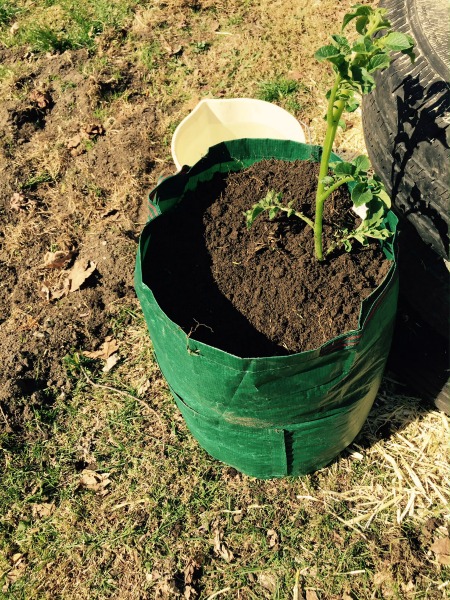 Not sure if this will work, my plant outgrew the height of the bag!
Not sure if this will work, my plant outgrew the height of the bag!
Experiment 2. Straw
First, you start by picking a garden area that gets full sunlight. You want the soil to be loose, so turn it over once and work in some fertilizer to help the potatoes grow.
the seed pieces are only planted on the surface of the soil when planting potatoes in straw. When you grow potatoes in straw you will see the sprouts quickly. Once they have grown four to six inches, you will want to cover them with more straw until only an inch of the new growth shows through. Then you want the plants to grow another four to six inches. Growing potatoes in straw isn’t difficult. They do all the work. Keep repeating this procedure for two or three more cycles. If there isn’t much rain, be sure to water them. When growing potatoes in straw, harvest time is easy. When you see flowers, you will know that there will be small new potatoes under the straw. Reach in and pull some out! If you prefer bigger potatoes, growing potatoes in straw is a great way to get them. Simply let the plants die off, and once they die, the potatoes are ripe for the picking. Potatoes can tolerate light frost, but when the first hard frost is expected, it’s time to get out the shovels. In areas where the fall is cool, but without frost, soil temperature will dictate when to pick potatoes. Your soil needs to be above 45 F.
Experiment 3. Grow Potatoes in Tires
This is a great alternative to the traditional way of raising potatoes in rows and best for any confined space.
Growing potatoes in tires is inexpensive, easy, and a good way to recycle old tires!
Potatoes don’t like wet feet so have good drainage below the tires.
Sunny area.
- Choose a sunny spot in your yard, garden or on a patio or balcony.
- Stack two or three tires and fill them with damp earth and compost to just over half the depth of the stacked tires.
- Then place 4 or 5 seed potatoes in the stack, about 2 inches deep, with the eyes or shoots facing up.
- Cover with a couple of inches of soil and don`t forget to water
- As the plants grow to about 2 to 4 inches, add another tire to the stack.
Add more soil or straw around the young plants as well to support them.
Continue mounding up the soil or straw around the emerging plants until your stack is 3 tires high.
Young potatoes will be forming all the way up the stack of tires
This past Saturday, I went out to check my potato plant growing in the tire. It was gone! Not a trace! I tore off each tire only to find straw. I am not sure if someone was messing with me and pulled it out, or if a critter got to it from underneath? The potato plant in the bag is still growing like a beast.
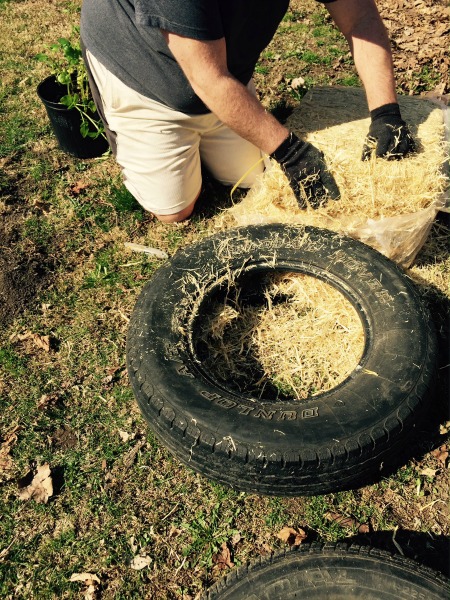
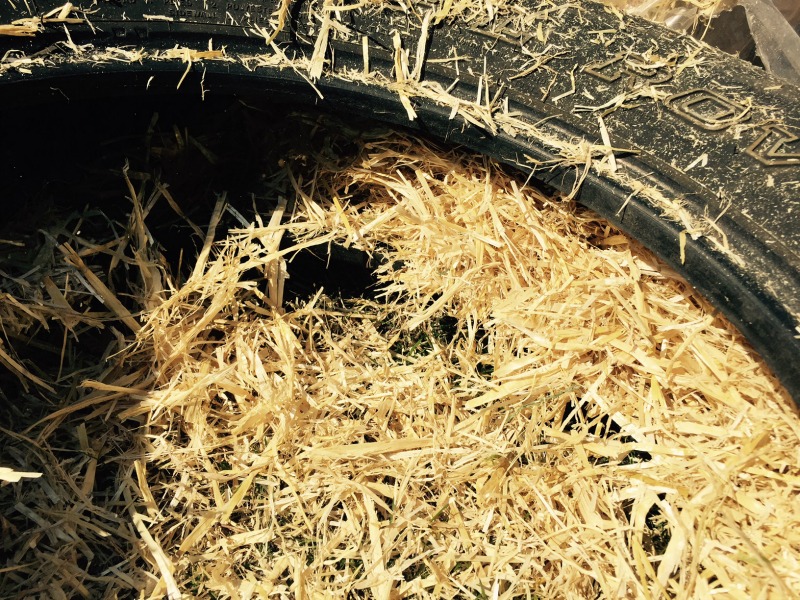
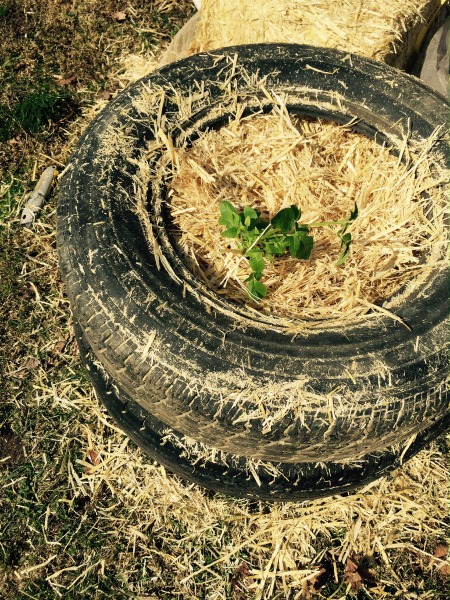
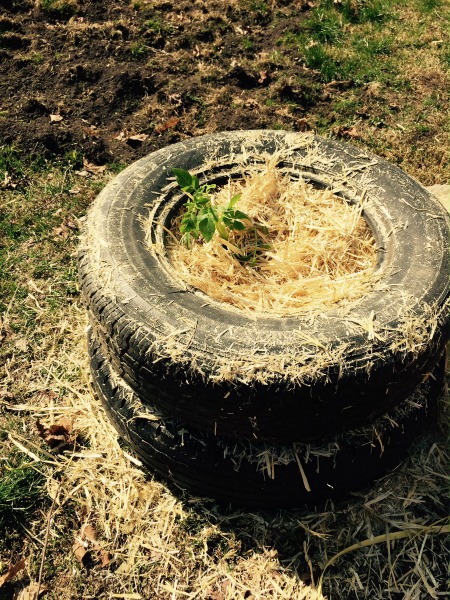
Hi, Mike. Great stuff and wonderful information. Thank you and God bless!
I found this video several years ago on youtube.. The site is “Growing Australia” and the gardener is Peter Cundall, who I believe has sadly passed on.
https://www.youtube.com/watch?v=q1OShZZUt0k
This got me re-introduced to organic and no-till gardening. I did it Peter’s way and got good results. the potatoes that I missed volunteered last year and did even better after I did it Rugh Stout’s way and just covered them with straw.
If the link does not work, you can google growing potatoes in Australia and it will pop up.
Again, thanks a million for your enthusiasm and wonderful passion and insight!
Thanks Jack, great information!
I have a question about the tire method, when the tire heats up in the sun, will the stuff the tires are made with leech into the potatoes and poison the potatoes?
I have read such conflicting stories and was wondering if you researched this?
I enjoy everything you write and share it with the community garden that I run. Thanks for all your hard work.
Kimberly,
I did not write this article, somebody else wrote it for us. So I don’t honestly know the answer.
Hi, Mike! I really enjoy your articles; you cover everything in a very easy to understand method. I was very excited to try growing potatoes this year and got some really nice seed potatoes online. I did the grow bag method and the potato foliage was impressive! But when they flowered and died back suddenly, I found nothing growing in the soil. Nothing! It was like your tire method story. What happened?
Margaret,
I’m not sure why a healthy potato plant would not produce potatoes. I’d be inclined to question the seed potatoes but there are other variables here that I am not aware of so the explanation might be more obvious. I’d try buying the seed potatoes locally from a garden center or feed mill and get some pointers from them to see what they can suggest.